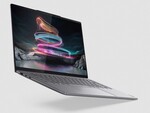Lenovo Yoga Pro 7 14IMH9
Especificaciones de Portátil(es)

Price comparison
Promedio de 3 puntuaciones (de 6 análisis)
Análisis para el Lenovo Yoga Pro 7 14IMH9
Con los procesadores Core Ultra, Intel quiere por fin alcanzar a AMD en lo que respecta al rendimiento de la iGPU. Hemos analizado el Lenovo Yoga Pro 7 14 para ver si pueden conseguirlo. ¿Será un éxito el regreso de Intel?
Origen: Laptop Media

Support, disponible online, Muy corto, Fecha: 08/01/2024
Origen: Laptop Media
 EN→ES
EN→ESThe Lenovo Yoga Pro 7i (14″, Gen 9) is an almost perfect compact laptop for content creation or other color-sensitive work. The dual-fan cooling solution is doing its job well during heavy loads where the optional Intel Core Ultra 7 155H can sustain 2.80 GHz / 2.40 GHz P and E-core frequencies in longer stress. The GeForce RTX 4050 has zero problems maintaining a 60W TGP while it’s utilized for gaming or other graphics-heavy job. In this scenario, the noise is average and the keyboard doesn’t feel hot to the touch. Speaking of which, the board is comfortable for typing and the big touchpad is very smooth. The port selection is modern but it’s also a bit limited since you lose one of the Type-C ports when the charger is plugged in. If you need a dGPU, you’ll end up with a laptop with just one M.2 slot – the iGPU-only siblings got two of these.
Único Análisis, disponible online, Muy largo, Fecha: 07/31/2024
Origen: Zdnet.com
 EN→ES
EN→ESPrices for the Lenovo Slim 7 starts at $899 with a few configuration options available. My review unit cost $1,116 sporting 32GB of memory and an Intel Core Ultra 7 CPU. You can opt for the Ultra 5 if you like. Would I recommend this laptop? Not really. It's certainly a decent machine. Lenovo made this laptop travel-friendly: it's durable, has a long battery life, and is lightweight at around three pounds. However, these three features alone don't cut it for me. The device's hardware can't handle tough workloads like graphic design; there are other machines better suited for that type of work. And its nearly $1,000 price tag makes it a hard sell for me. There are other options out there that can do the same thing, if not better. One of those laptops is the 12th-generation Lenovo ThinkPad X1 Carbon. It's a bit more expensive than the Slim 7, but it's worth the price. Another option would be the Asus ROG Zephyrus G14, a lightweight and portable alternative.
Único Análisis, disponible online, corto, Fecha: 03/25/2024
Origen: Digital Trends
 EN→ES
EN→ESThe Slim 7i Gen 9 would have been a standout laptop a few years ago, offering class-leading performance and an OLED display at midrange and near-budget pricing. Today, it faces a lot more competition, and it’s held back by lesser battery life. Even so, there’s a lot to like. The keyboard and touchpad are very good, the chassis is solidly built, and it looks good. At its price of $1,050, it offers a great configuration. I can give it a recommendation, and if Lenovo pushes a configuration to around $800, it will rate even higher.
Único Análisis, disponible online, Mediano, Fecha: 03/21/2024
Puntuación: Puntuación total: 70%
Origen: PC Welt
 DE→ES
DE→ESÚnico Análisis, disponible online, largo, Fecha: 07/22/2024
Puntuación: Puntuación total: 80%
Origen: Laptopmedia CN
 zh-CN→ES
zh-CN→ESÚnico Análisis, disponible online, Muy largo, Fecha: 07/31/2024
Comentario
Intel Arc 8-Core: Tarjeta gráfica integrada basada en la arquitectura Xe LPG (similar a las GPU Arc dedicadas, pero centrada en la eficiencia). Proporciona los 8 núcleos Xe (128 motores vectoriales Xe) y 8 unidades de trazado de rayos.
Estas tarjetas también deben ser capaces de aguantar todos los juegos actuales, pero la mayoría de ellos en configuraciones de detalles medios y bajos y con bajas resoluciones. Juegos más antiguos, o menos exigentes todavía pueden ser jugados con buena calidad de gráficos.
>> Más información puede ser encontrada en nuestra comparación de tarjetas gráficas moviles y la lista de benchmarks.
Ultra 7 155H: Un chip Meteor Lake de gama alta que debutó en diciembre de 2023. Este procesador Core Ultra de primera generación ha venido a sustituir a los chips Core de 13ª generación; dispone de 16 núcleos (6 + 8 + 2) y 22 hilos. Sus núcleos de rendimiento, de los que hay 6, funcionan hasta a 4,8 GHz mientras que sus núcleos eficientes, de los que hay 10 (8 núcleos principales más 2 extra que se encuentran en la isla de bajo consumo) funcionan hasta a 3,8 GHz. La NPU AI Boost integrada ofrece dos motores Gen 3 para la aceleración de cargas de trabajo de IA por hardware. El consumo de energía "mínimo asegurado" de este procesador para portátiles es de 28 W, mientras que su consumo de energía Turbo se supone que se mantiene dentro de los 115 W.
>> Más información puede ser encontrada en nuestra comparación de procesadores móviles.



